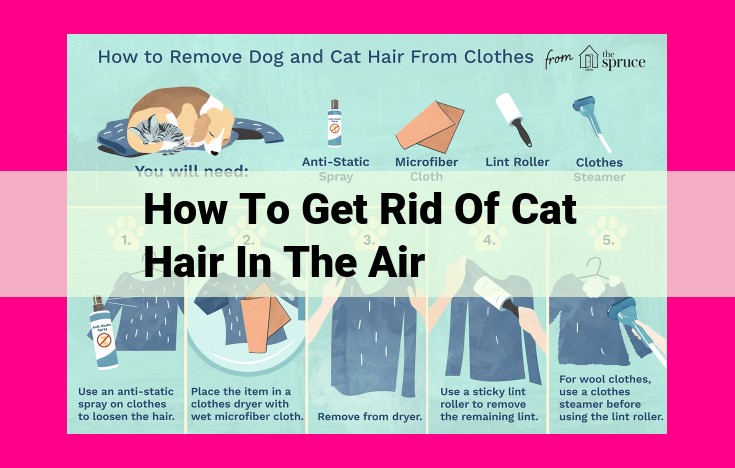Ridding Your Home Of Cat Hair: Tips And Strategies For A Clean And Allergy-Free Environment

To rid the air of cat hair, employ effective cleaning methods like vacuuming, using an air purifier, or wiping with a damp cloth. Regular cat brushing, frequent vacuuming, and using hypoallergenic litter also minimize hair in the environment. To alleviate allergies, ensure cat health, address allergies, improve indoor air quality, and keep cats out of certain areas.
Effective Pet Hair Removal: A Cleaning Masterclass
As devoted pet owners, we relish the companionship of our furry companions. However, one inevitable challenge that comes with pet ownership is the ubiquitous presence of pet hair in our homes. Excessive pet hair can not only be aesthetically unappealing but also exacerbate allergies for some individuals. Fortunately, there are myriad cleaning methods and strategies that can effectively combat this hairy nuisance. In this comprehensive guide, we’ll explore the most effective pet hair removal methods, delve into the benefits of specific products and techniques, and offer valuable tips for mitigating cat allergies.
Cleaning Methods for Effective Pet Hair Removal
Vacuuming:
Vacuuming is an indispensable tool for pet hair removal. Regular vacuuming can effortlessly extract pet hair from carpets, rugs, and furniture. To maximize effectiveness, select a vacuum with a powerful suction capacity and a specialized pet hair attachment. HEPA filters, which trap even the smallest hair particles, are highly recommended.
Using a HEPA Air Purifier:
HEPA air purifiers are highly efficient devices that remove pet hair and other allergens from the air. They create a cleaner and healthier indoor environment by effectively capturing microscopic particles suspended in the air. Consider placing HEPA air purifiers in areas frequented by your pets or prone to pet hair accumulation.
Damp Cloth:
A damp cloth can be an effective way to remove pet hair from surfaces such as countertops, chairs, and pet bedding. The moisture helps attract and trap pet hair, making it easy to wipe away. Remember to rinse the cloth frequently to prevent it from becoming saturated with pet hair.
Pet Hair Remover Glove:
Pet hair remover gloves feature a textured surface that effortlessly lifts pet hair from clothing, furniture, and other surfaces. These gloves are particularly handy for removing hair from upholstery and fabrics. Simply don the gloves and gently rub the affected area to remove loose hair.
Pet Grooming Brush:
Regularly brushing your pet can drastically reduce the amount of loose hair shed around your home. Use a brush specifically designed for your pet’s coat type to effectively remove dead hair and prevent matting. By brushing your pet outdoors or over a shower drain, you can minimize hair dispersion within your living space.
Products and Techniques for Effective Hair Removal
Regular Cat Brushing:
- Regular brushing removes loose hair before it spreads throughout the house.
- Use a soft-bristled brush specifically designed for cats.
- Brush your cat daily or several times a week to minimize hair buildup.
Frequent Vacuuming:
- Vacuuming frequently, especially in high-traffic pet areas, is crucial for capturing pet hair.
- Use a vacuum with a HEPA filter to effectively trap allergens.
- Vacuum carpets, furniture, and other surfaces where your cat spends time.
Hypoallergenic Cat Litter:
- Hypoallergenic cat litter can help reduce the amount of dander and hair in the air.
- Look for litters that are made from natural materials like pine or corn.
- Regular litter box cleaning is essential for maintaining a clean environment.
Well-Ventilated House:
- Proper ventilation circulates air and reduces the concentration of pet hair and allergens.
- Open windows and doors whenever possible.
- Consider using air purifiers with HEPA filters to further improve indoor air quality.
Keeping Cats Out of Certain Areas:
- Limiting your cat’s access to certain hair-prone areas can minimize the spread of hair.
- Keep cats out of bedrooms or other areas where you spend significant time.
- Provide cats with designated spaces, such as pet beds or cat trees, to reduce hair buildup in other areas of the house.
Mitigating Cat Allergies: The Importance of Health, Cleaning, and Air Quality
Are you a cat lover perpetually sniffing and sneezing from feline-induced allergies? Don’t despair! By understanding the causes and implementing effective strategies, you can minimize allergic reactions and enjoy the companionship of your furry friend without compromising your well-being.
The Importance of Cat Health
- Regular Veterinary Care: Routine checkups can detect and treat underlying health issues that exacerbate allergies.
- Grooming: Regular brushing removes loose hair and dander, reducing the amount of allergens in the environment.
- Healthy Diet: A balanced diet promotes a healthy immune system and reduces inflammation.
Addressing Common Cat Allergies
- Feline Allergen Fel d 1: Primarily found in cat saliva and dander, it triggers allergic reactions in most people.
- Contact Dermatitis: Allergic reactions to cat saliva or dander can cause skin rashes and irritation.
- Asthma: In severe cases, cat allergies can trigger asthma attacks.
The Role of Household Cleaning
- Vacuuming Frequently: Use a vacuum cleaner with HEPA filter to remove pet hair and dander from carpets, furniture, and bedding.
- Damp Cleaning: Use a damp cloth to wipe down surfaces, capturing allergens before they become airborne.
- Pet Hair Remover Glove: Pet hair remover gloves can effectively remove hair and dander from clothes and furniture.
Improving Indoor Air Quality
- Ventilation: Open windows and doors to enhance airflow and reduce allergen buildup.
- HEPA Air Purifier: HEPA air purifiers effectively remove pet hair, dander, and allergens from the air.
- Hypoallergenic Cat Litter: Choose hypoallergenic cat litter to minimize dust and allergen release.
- Restrict Cat Access: Limit your cat’s access to certain areas, such as bedrooms, where you spend significant time.
By prioritizing cat health, implementing regular cleaning routines, and improving indoor air quality, you can significantly reduce cat allergies and maintain a healthy and harmonious environment for both you and your feline companion. Embrace these strategies and enjoy the joys of cat ownership without the discomfort of allergies.